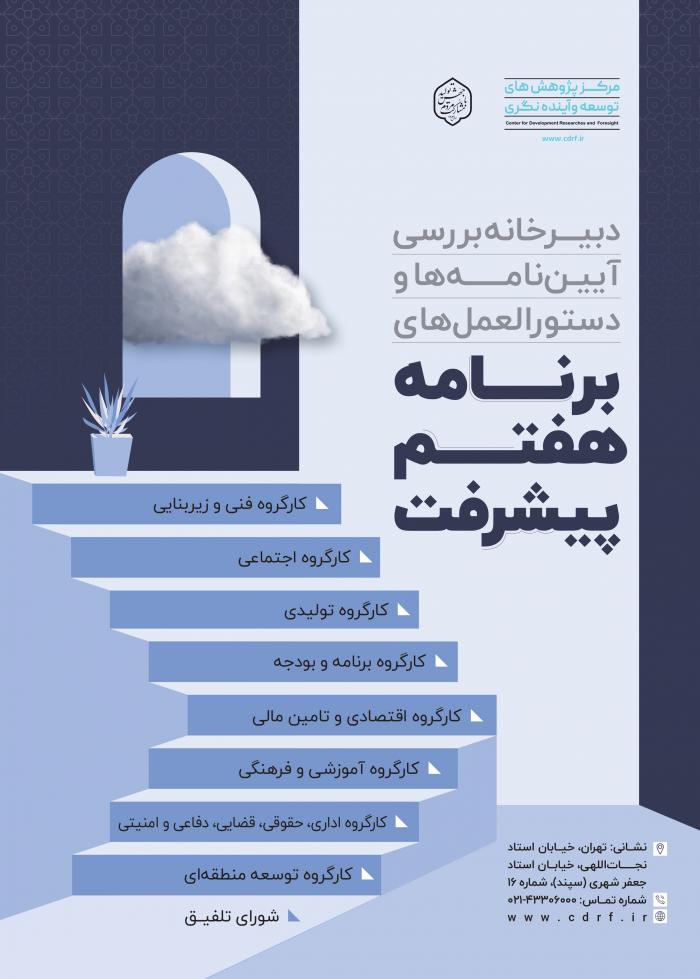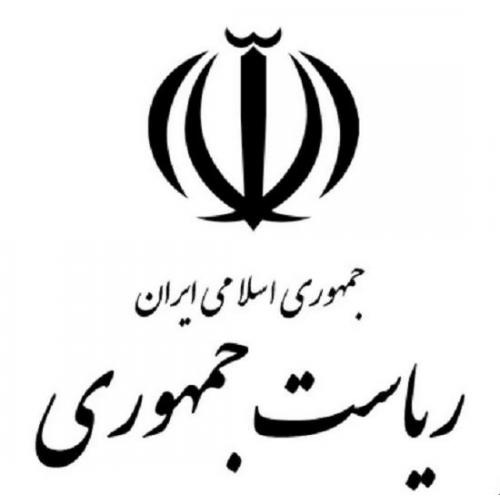

-
بررسی آییننامهها و دستورالعملهای برنامه هفتم پیشرفت
-
بررسی عوامل موثر بر افزایش تصادفات و تلفات جادهای و سوانح رانندگی و دادهکاوی تلفات انسانی
-
سازماندهی و بازآرایی فضایی آموزش عالی کشور
-
به روز رسانی سند ملی آمایش سرزمین
-
انجام مطالعات مناطق آزاد به عنوان نواحی پیشران اقتصادی کشور
-
اصلاح ساختار بودجه و پیاده سازی نظام یکپارچه مدیریت اطلاعات مالی دولت (IFMIS)

At the beginning of the meeting, Farrokh Masjedi, Special Representative of the Head of the PBO for the Preservation and Restoration of the Zagros Forests and the scientific chair of the meeting, highlighted the critical importance of the Zagros forests to Iran from various perspectives. He stated that the Zagros forests span approximately 30 million hectares; however, both the quality and quantity of these forests have been declining over time. He emphasized that the forests are facing serious challenges and that effective measures must be taken to address these pressing issues.
He further elaborated that approximately 40 percent of Iran’s water resources are supplied through these forests. The degradation of the Zagros forests not only exacerbates water-related challenges but also increases the risk of flooding, which in turn can lead to a cascade of subsequent problems. Additionally, these forests are critical for oxygen production as they provide part of Iran’s oxygen. Therefore, their destruction would disrupt Iran’s oxygen supply. Thirdly, the forests serve as a natural barrier against transboundary dust storms; thus, their decline would contribute to worsening air pollution, particularly in border regions.
The Special Representative of the Head of the PBO for the Conservation and Restoration of the Zagros Forests added that one of the most pressing issues in recent years concerning these forests is the growing incidence of wildfires. Over the past few years, the number of forest fires has increased by approximately 40 percent, while the total area affected by fires has surged by nearly 300 percent. This alarming trend demands serious attention to both the underlying causes and effective control strategies. Unfortunately, it must be noted that nearly 70 percent of all recorded wildfires in Iran have occurred in the Zagros region, underscoring the urgency of addressing this critical environmental threat.
Masjedi elaborated that, until now, matters related to forest conservation had primarily been delegated to the Forests and Watershed Management Organization. However, it has become evident that the protection of forests and natural resources cannot be effectively managed by a single organization. The lack of success in this area may, in fact, be attributed to such a fragmented and sectoral approach. Going forward, all relevant executive bodies must collectively contribute and coordinate their efforts to ensure the sustainable preservation of Iran's natural resources and forests.
Later in the meeting, Reza Siah Mansour, a faculty member of the Agricultural and Natural Resources Research and Education Center of Lorestan Province, speaking as one of the key speakers of the meeting, stated: “A significant portion of the destruction and wildfires in the Zagros region stems from decisions made outside Iran. Therefore, some of the existing problems and challenges facing these forests may be attributed to international factors.”
He continued by stating that the first component of effective governance is an accurate depiction of the current situation. In other words, denying or concealing the truth will lead us nowhere.
He added that fostering motivation on one hand and enforcing firm deterrents on the other—alongside cultivating a sense of ownership among local beneficiaries toward national resources—constitutes a smart and impactful strategy that must not be overlooked. He posed a rhetorical question: why is it that, even during dry seasons, wildfires rarely occur when wheat, barley, and other rain-fed crops are still standing? Is it not because farmers protect them out of a deep sense of attachment? Therefore, applying the same model of stewardship to forests and rangelands emerges as one of the most practical and effective approaches to safeguarding these natural resources.
In presenting his policy recommendations, Siyah Mansour highlighted several critical measures, including: conducting thorough analysis and assessment of previous wildfires and the performance of response teams; designing differentiated strategies for various vegetation types across all three wildfire phases; placing special emphasis on post-fire management; refining studies and eliminating procurement-related constraints in natural resource management; employing fire-resistant species, particularly in high-risk areas; prohibiting the introduction of coniferous species into oak forests; encouraging land users to establish firebreaks around agricultural plots; registering trees with identification tags linked to the farmer’s profile; professionalizing and empowering the firefighting personnel; undertaking detailed analysis of each wildfire event with a focus on identifying both efficiencies and challenges; and ensuring the compatibility of fire suppression equipment with training for effective use.
As the meeting proceeded, Mehrdad Akbarian, Representative of the National Organization for Natural Resources and Watershed Management, delivered his remarks as the second main speaker. Highlighting wildfires as a major threat to natural resources, he stated: “Among destructive factors, wildfires receive particular attention globally due to their distinct nature, rapid spread, and severe impact on ecosystems. Even countries with well-established natural vegetation cover have developed dedicated terrestrial and aerial response units to prevent and contain such devastating incidents, which not only damage the environment but also pose serious risks to human lives.”
He continued: “Wildfires in Iran’s natural landscapes are a well-documented phenomenon, with statistical records over the past fifty years confirming their persistent occurrence. This phenomenon—among the most destructive threats to natural resources—often results from human negligence and, at times, natural causes. It has the potential to devastate vast areas of these resources in the shortest possible time.”
The representative of the Natural Resources and Watershed Management Organization continued: “In addition to destroying vegetation cover, wildfires cause a range of adverse effects including soil erosion, flooding, sedimentation of dam reservoirs, destruction of agricultural lands and forest beds, desertification, environmental degradation, outbreaks of pests and diseases, among others. Accurately estimating the full extent of the damages inflicted by these fires is either impossible or extremely challenging.”
He explained: “Factors such as sparks generated by trains running on tracks passing through areas with dense grass cover, the lifestyle of local communities and nomadic tribes, agricultural land expansion, and the spread of livestock grazing areas contribute to wildfire occurrences. Additionally, ethnic conflicts, the aftermath of war including unexploded ordnance, increased human presence due to the transit of smuggled goods through forested regions, intensive and unregulated exploitation, and the shift in the structure of western oak forests from seed-origin to sprout-origin—resulting in heightened fire susceptibility—are all significant causes of forest fires.”
Mehrdad Akbarian further noted that 95% of forest fires are caused by human factors. He categorized these human-related causes into two groups: intentional factors, accounting for 10 to 15%, and unintentional factors, comprising 85 to 90%. Intentional causes include fires set due to ethnic and tribal conflicts, arson by opportunists aiming to seize public lands, and fires deliberately ignited by herders to clear trees for enhanced forage growth. Unintentional causes encompass negligence by farmers and cultivators when burning agricultural residues, carelessness by tourists and hunters, military maneuvers, construction projects involving flammable materials, and the careless discarding of lit cigarettes or matches along roadways. Collectively, these factors constitute approximately 95% of the causes of forest fires.
He continued: “Wildfires in forests and natural resources lead to additional detrimental effects, including the exacerbation of emerging phenomena such as the decline of tree species like the Zagros oak, loss of natural forest regeneration, increased occurrences of flooding, landslides, and soil erosion, a severe reduction in soil fertility, destruction of wildlife habitats, and diminished capacity for water absorption and storage.
At the conclusion of his remarks, the Representative of the Natural Resources and Watershed Management Organization outlined the primary challenges facing the Zagros forests, including the vast and rugged terrain that limits rapid access; the inability to deploy aerial firefighting equipment due to financial and logistical constraints; the impact of climate change and the inability to manage drought conditions effectively; the lack of implementation of modern fire management technologies across the affected areas; insufficient and misaligned funding relative to the scope of firefighting responsibilities; a severe shortage of skilled personnel for firefighting operations; a lack of qualified contractors to support firefighting efforts; socio-economic and cultural issues; inadequate specialized equipment for ground firefighting operations; the absence of a dedicated aerial firefighting fleet within the sector of the natural resources of the Islamic Republic of Iran; and weak intention to conserve the natural resources and environment.
In the proceedings of the meeting, the experts and specialists expressed their viewpoints and posed their questions.
It is noteworthy that this meeting was held on November 26, 2024, both in-person and virtually, with the participation of national and provincial executive agencies, universities, research centers, and think tanks, at the Hossein Azimi Hall located in the CDRF.



